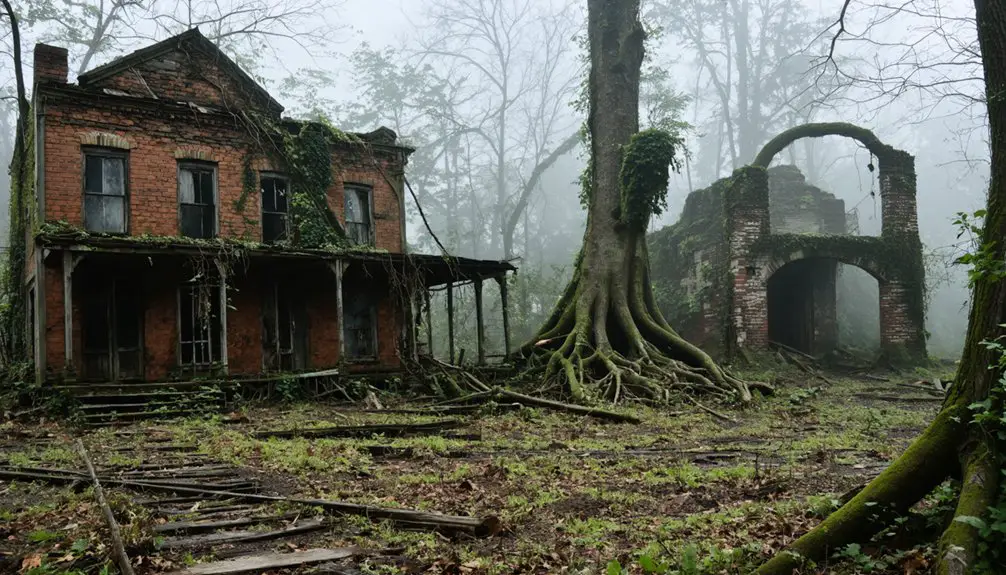You’ll find Hookerstown’s ruins in Pennsylvania’s coal country, where it once thrived as a prosperous mining town. The community peaked in the late 1800s, with miners paying $6 monthly rent while earning $20 weekly in company scrip. An underground mine fire in 1962 forced residents to abandon their homes, leaving toxic gases and unstable ground. The ghost town’s crumbling structures tell a broader story of America’s industrial past and labor struggles.
Key Takeaways
- Hookerstown transformed from a thriving coal mining town into a ghost town following the outbreak of an underground mine fire in 1962.
- Environmental hazards from toxic gases, soil contamination, and acid mine drainage forced residents to abandon their homes permanently.
- Government buyout programs purchased properties from remaining residents due to safety concerns related to dangerous mine subsidence.
- The town’s infrastructure, including schools and churches, deteriorated without maintenance as the population dwindled to zero.
- Physical structures now lie in ruins, serving as a stark reminder of Pennsylvania’s coal mining heritage and industrial decline.
The Rise of a Mining Community
While coal mining in Pennsylvania dates back to the colonial era, Hookerstown’s story began in earnest during the mid-19th century amid the region’s expanding industrial revolution.
You’ll find its foundations firmly rooted in the discovery of rich coal seams, including the productive Harrisville, Burnett, and Slope veins that drew enthusiastic prospectors and laborers to the area. Early settlers relied on coal primarily for forges and blacksmiths starting in the 1790s.
The community dynamics shifted dramatically as transportation infrastructure expanded, particularly with the completion of the Pennsylvania Canal and Allegheny Portage Railroad in 1834. A significant milestone was reached when the Huntingdon Railroad was constructed in 1853, enabling more efficient coal transportation.
These developments transformed labor conditions, enabling miners to extract and transport hundreds of tons of coal daily to meet Pittsburgh’s growing industrial demands.
The change from charcoal to coke production in iron manufacturing further cemented Hookerstown’s strategic importance as a mining hub in western Pennsylvania’s burgeoning coal industry.
Life in the Coal Company Town
As coal production ramped up in Hookerstown during the 1920s, miners found themselves living in a rigid company-controlled system where nearly every aspect of their lives fell under corporate oversight.
Many families had to adjust from Hookstown’s earlier days when red brick homes were the standard dwellings for residents.
You’d find yourself paying $6 monthly rent for a hastily built company house, while earning around $20 per week mining coal at 38 cents per ton.
But don’t expect to see much of that money – the company would deduct rent, medical care, and store credit before you’d even touch your paycheck.
Workers often received their wages in company scrip, forcing them to make all purchases at inflated prices from the company store.
Miners’ families couldn’t escape company control, as they depended on corporate-owned facilities for everything from schools to entertainment.
In these isolated communities, you’d share space with immigrant neighbors in what historians describe as a feudalistic system, where the company acted as employer, landlord, shopkeeper, and unofficial law enforcer.
Transportation and Trade Networks
Located at a strategic crossroads, Hookerstown connected major trade routes from Pittsburgh and Washington, Pennsylvania by 1817, establishing itself as an essential transportation hub.
You’d find the town’s main road linking to Georgetown on the Ohio River and Dawson’s Ferry, while local farmers collaborated on road improvements along Logstown Run to access railroad services in nearby Legionville.
While you wouldn’t see direct rail service in Hookerstown, the surrounding trade routes thrived through a network of turnpikes and ferry crossings.
Charles Bruce’s ferry operation on the Ohio River created crucial connections between rail and road networks.
The town’s position near these transportation arteries supported local businesses like inns, taverns, and mills, though it maintained its rural character even as the region’s infrastructure expanded.
The Pittsburgh and Lake Erie railroad’s arrival in 1877 transformed regional transportation, though Hookerstown remained dependent on its road connections.
The area gained additional significance with the development of US Route 30 which passed through nearby Beaver County as a vital east-west corridor.
Mining Operations and Economic Peak
During the mid-1800s, Hookerstown’s economy surged with the discovery of rich bituminous coal deposits throughout the region. You’d find miners working grueling 10 to 16-hour days using room-and-pillar techniques, the dominant mining innovation of the era. Coal extraction utilized drift mines in the area’s accessible coal seams.
The town’s mines attracted a diverse workforce, including Welsh and Italian immigrants who’d risk their lives daily in hazardous underground conditions. Many faced constant dangers from fire and explosions, making each shift a potentially deadly endeavor.
As mining operations expanded, you could see Hookerstown’s prosperity grow alongside Pennsylvania’s booming steel industry. The town experienced significant economic fluctuations tied to coal production, which fed Pittsburgh’s voracious industrial appetite of over 400 tons daily by 1830.
Local mines contributed to Pennsylvania’s dominance in coal output, helping the state produce nearly half of America’s coal by the late 19th century.
Environmental Impact and Challenges
The environmental toll of Hookerstown’s mining legacy became devastatingly clear through an underground coal fire that ignited in 1962, mirroring the infamous Centralia disaster. Early attempts to stop the spread using water and sand proved futile.
You’ll find the fire’s ongoing impact has created severe environmental hazards, releasing toxic gases like carbon monoxide and sulfur dioxide into the atmosphere while degrading local air quality.
The area’s soil contamination presents another critical challenge, with heavy metals and coal byproducts leaching into surface soils.
Heavy metals and toxic coal residues continue to poison Hookerstown’s soil, creating an environmental hazard that persists decades later.
You won’t see much vegetation in certain areas due to poor soil quality, and acid mine drainage has devastated local waterways.
Ground stability remains a persistent threat, with dangerous fissures and subsidence making much of the land unusable. Similar to Centralia’s Todd Domboski incident, many dangerous sinkholes appeared throughout the area.
The contaminated groundwater and persistent toxic emissions ultimately forced residents to abandon their homes.
The Town’s Gradual Abandonment
As Hookerstown’s coal industry collapsed in the mid-20th century, widespread unemployment triggered a devastating chain reaction of economic decline and population loss.
You’d have witnessed dramatic demographic shifts as younger residents left for urban opportunities, while aging community members struggled to maintain their way of life.
The community decline accelerated as local businesses shuttered their doors, following the closure of company stores and mining operations.
You’d have seen houses emptying one by one, with remaining structures falling into disrepair.
The town’s infrastructure crumbled without proper maintenance, while schools and churches closed their doors permanently.
Government buyout programs eventually stepped in, purchasing properties from the few remaining residents.
Safety concerns from mine subsidence and environmental degradation ultimately sealed Hookerstown’s fate, transforming it from a bustling coal town into an abandoned ghost town.
Legacy in Pennsylvania’s Coal Region

While Hookerstown’s physical structures have crumbled into ruins, its legacy endures as a stark reminder of Pennsylvania’s complex coal mining heritage dating back to the 1760s.
You’ll find its story intertwined with the region’s rich veins of bituminous coal, including the profitable Harrisville, Burnett, and Slope seams that once fueled America’s industrial might.
Like many coal towns, Hookerstown witnessed the struggle between labor and management, as miners fought for better wages and safer working conditions.
Their activism helped shape the labor movements that defined Pennsylvania’s mining communities.
Today, though the mines have closed, Hookerstown’s abandoned sites stand as evidence to the sacrifices of generations of miners who risked their lives in the depths, contributing to the industrial revolution that transformed America.
Frequently Asked Questions
Are There Any Documented Paranormal Activities or Ghost Sightings in Hookerstown?
You won’t find official records of ghost encounters or paranormal investigations in the area. While nearby Pennsylvania ghost towns have documented supernatural claims, there’s no credible evidence of paranormal activity here.
What Happened to the Cemetery and Burial Grounds After the Town’s Abandonment?
You’ll find limited cemetery preservation efforts documented for the burial grounds, as they likely followed the typical pattern of Pennsylvania ghost town cemeteries – falling into neglect and gradually becoming obscured by natural overgrowth.
Did Any Notable Crimes or Disasters Occur in Hookerstown’s History?
You won’t find documented crime history or disaster incidents here – while Pennsylvania mining towns often faced troubles, research shows no specific catastrophes or notorious criminal events in Hookerstown’s scattered records.
Where Did Most of Hookerstown’s Former Residents Relocate To?
You won’t find clear relocation patterns for Hookerstown’s residents since historical records don’t track their specific movements, though many likely followed former industries to nearby Pennsylvania mining and manufacturing towns.
Are There Any Surviving Photographs or Maps of Hookerstown’s Layout?
Like 75% of Pennsylvania’s ghost towns, you won’t find surviving photographs or detailed maps of the layout. Historic preservation efforts haven’t yielded any confirmed visual documentation of this vanished coal community.
References
- https://pabucketlist.com/the-rise-and-fall-of-centralia-pas-toxic-ghost-town/
- https://indianacountyparks.org/our-trails/ghost-town-trail/ghost-town-trail-history/
- https://www.youtube.com/watch?v=Qj5LjacccJ0
- https://www.youtube.com/watch?v=HHPt6Tbbx7E
- https://en.wikipedia.org/wiki/List_of_ghost_towns_in_Pennsylvania
- https://www.heritagejohnstown.org/attractions/heritage-discovery-center/johnstown-history/history-coal-cambria-county/
- https://www.grovecityhistoricalsociety.org/wp-content/uploads/2014/05/Grove-City-1880-1889-2003r.compressed.pdf
- https://www.iup.edu/library/departments/archives/coal/coal-culture-timeline.html
- https://www.pa.gov/agencies/dep/programs-and-services/mining/bureau-of-mining-programs/pa-mining-history.html
- https://genpa.org/public-collections/pennsylvania-resources/mining-resources/



